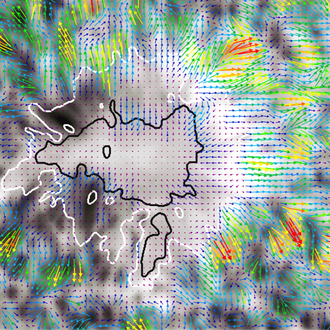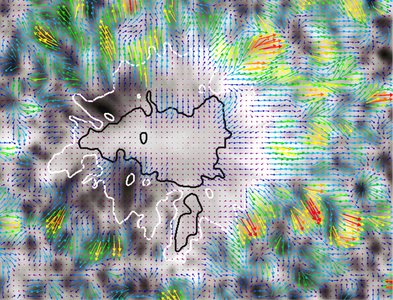Sun in sight: Tailored solution for collaborative research

Three-dimensional flow field on the Sun on September 26, 2016, reconstructed from GREGOR data.
Credit: AIP/C. DenkerSince 2014, Europe's largest solar telescope GREGOR has been used for scientific measurements and has collected large amounts of very complex, multidimensional data during this time. To make these immense amount of data usable and accessible for the research community, scientists of the departments of Solar Physics and E-Science at the Leibniz Institute for Astrophysics Potsdam (AIP) have now developed a Collaborative Research Environment (CRE). The results were presented in a recently released special issue of the Astrophysical Journal Supplement Series on Big Data in Solar and Stellar Physics.
With the GREGOR telescope astronomers of the AIP study active dynamic processes on the Sun with high spatial, temporal and spectral resolution. In terms of observations and data acquisition, they face particular challenges arising from various factors: Turbulence in the Earth's atmosphere affects the image quality, small solar structures develop on short time scales of a few seconds to minutes, and large-format detectors generate very large amounts of data.
"With the powerful instruments of the GREGOR telescope we are able to detect even the smallest structures on the sun's surface and provide time series of high-resolution images every 10 to 20 seconds," says Prof. Carsten Denker, head of the working group Optical Solar Physics at the AIP. "A reconstructed image every 20 seconds is based on a few hundred individual image frames. That's about 200,000 images or 4 terabytes per observation day."
The large number and high-resolution of images and spectra as well as the required computational effort in the post-processing require extensive and efficient structures for storage and archiving. In order to make the GREGOR data optimally usable and accessible, a dedicated CRE has now been implemented at AIP. This infrastructure served initially as a central data hub within the GREGOR consortium, but is now open to all interested scientists. It provides data space and access, computational resources and customized tools for analysis and processing. Collaborators have also the option to publish selected and curated data for the solar community via the CRE.
In order to make research data available to as many scientists as possible or even to the interested general public, the open access paradigm has gained increased importance in recent years. The newly developed CRE for GREGOR data also builds on this concept and is specifically tailored toward the requirements of the high-resolution solar physics community. In the now published article, AIP scientists around Prof. Carsten Denker give an overview of the GREGOR data –from the photons arriving at the detector to the final data products. In addition, they describe the developed approach for the systematic processing, analysis, management and archiving of these data.
The development of research technology and e-infrastructure is a strategic goal of AIP. In close collaboration between the two research areas of E-Science and Solar Physics, a tailor-made solution was developed for the data-specific challenges of high-resolution solar observations obtained with ground-based solar telescopes such as GREGOR.
Further information
GREGOR consortium
Kiepenheuer Institute for Solar Physics, Freiburg
Leibniz Institute for Astrophysics Potsdam (AIP)
Max Planck Institute for Solar System Research, Göttingen
Instituto de Astrofísica de Canarias, Canary Islands
Further information
Publication
https://doi.org/10.3847/1538-4365/aab773
Solar telescope GREGOR
Collaborative Research Environment (CRE)
Images
Three-dimensional flow field on the Sun on September 26, 2016, reconstructed from GREGOR data.



